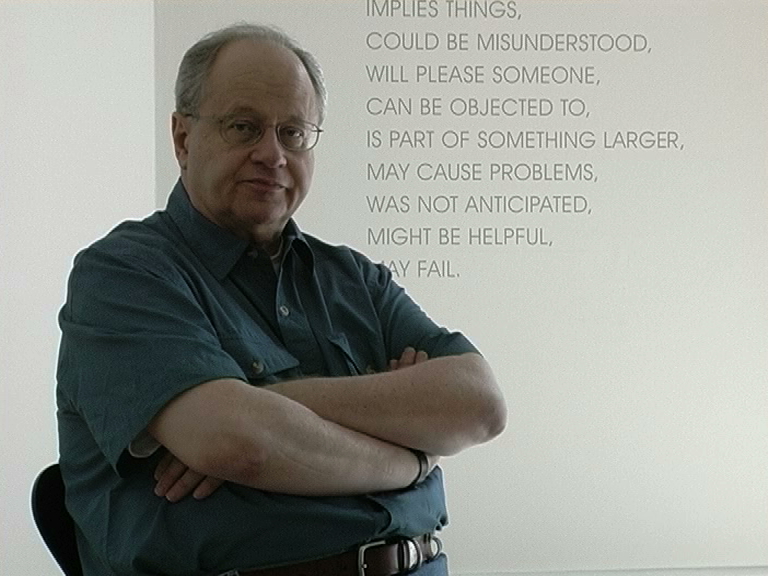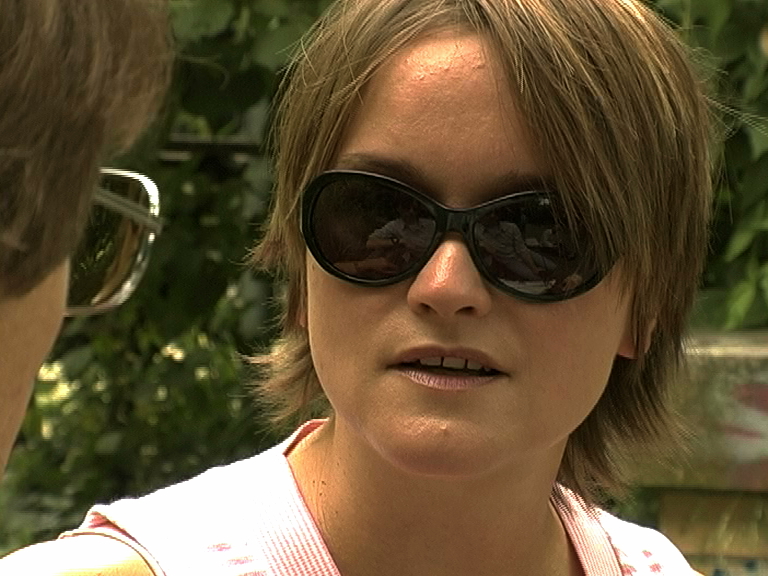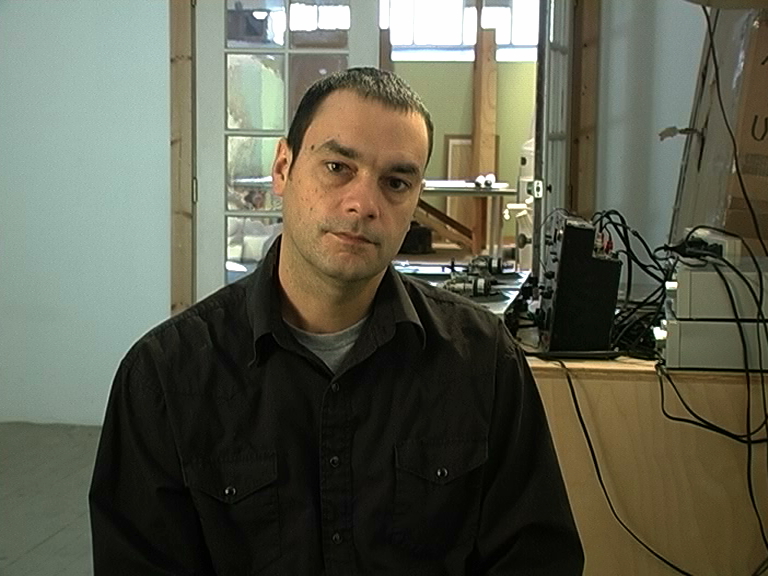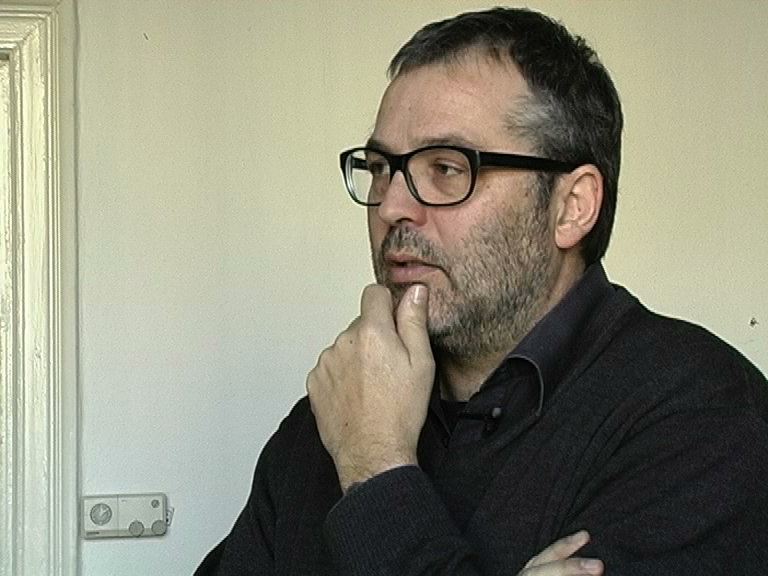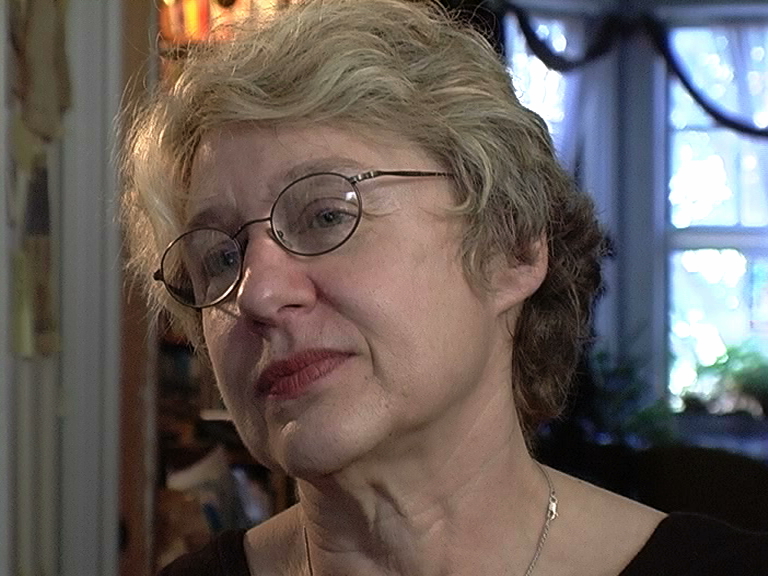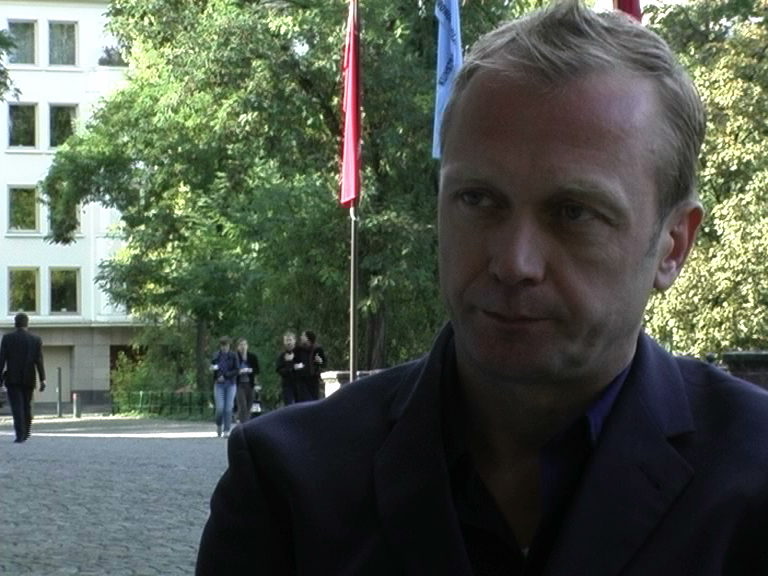S.R.: We are guests in the house of Sol LeWitt and it’s October 2nd, 2004.
I always – as a great admirer of your work – asked myself how did you come to the point that you developed these ideas on Conceptual Art, these sentences and paragraphs on Conceptual art. Can you give us a little bit the background?
S.L.: We have to go back to the early 60s, and, of course, there’s the idea of Minimalism that was – as a reaction to Abstract Expressionism here – and it took different ways – Pop art was one, Minimal was another, but I was involved in the Minimal art mainly. It seemed to me that, at a point, that Minimal art was a dead end, that it was in itself a formal idea – based in the idea of form – whereas it seemed like that it had the idea of form as simplicity and form as a unit, but it seemed like it was, to me, a dead end. It seemed to be not an idea that would develop more because it had become more and more simple, it had become more inward-looking in itself and I felt that there were two… – one thing was that I wanted to make it more dynamic. One of the reasons, one of my background ideas was the art of Eadward Muybridge who was to me one of the really great thinkers of modern art, and the idea of a serial progression came from that, and I thought that – what I wanted to do was to make … instead of an art of form into an art of content, so that the art would in a way tell a story. The kind of story that I wanted to tell was based still on the function of art the function of colour, the function of form, line, the idea of form becomes an idea of cube. But then I had the idea that… to make a system, and the first system was to do with a form within a form, and the basic form that I was involved with was the cube, but the basic component of the cube was the square. So you had the idea of a square within a cube or a cube within a square, and then the idea that… make it all of the possible combinations, which made it into a finite system. There was the first large idea that I had that came out of the idea of Minimalism, but I had the idea of a, perhaps we’ll say, a concept that ignited the system or the series. So that for instance with Muybridge it was the idea of moving objects, moving figures. And I wanted to make a moving idea – of an idea that had movement. That was how I started to think about doing – first – art in series and art as a total kind of idea of movement and of content and system, and then went on from that.
S.R.: You said that Eadward Muybridge was one of your relation points or thinking points. What else in the world, or you said you wanted to do something like the opposite of Abstract Expressionism. What else would you call or consider as an influence – if you use this word – in the world, for your thinking, for your background, for your context?
S.L. Well, through the time of Minimalism there were other people involved in this sort of thing. One of the most important pieces at that time was the Dan Flavin piece – the »Nominal Three«: which was »one, one-two, one-two-three« with the fluorescent bulbs. And the other was Judd’s Progression Pieces. But the Judd pieces were very complex and not many people really understood, but the Flavin piece was the absolute minimal idea of a movement, and that was the first kind of idea of a movement that was around at that time. When we talk about the origins of Conceptual art, one thing that myself and people were thinking more or less like I was, that came out of minimalism – was that the rejection of the idea that came through Duchamp into art in the idea of irony. We didn’t want to have anything to do with Pop art except in a very minimum manner. There were certain kinds of cross-references, but one thing that the kind of conceptualism that I’m really involved with, was also a rejection of basically French art and Duchamp that injected the idea of irony into art that eventually became Pop art. That was the reason that much of Minimal Art was more derived from Russian Constructivism or Supremacism (sic), that was in a way much more interesting than French art at that time; there was a rejection of French art as well because we thought that Abstract Expressionism was the last big statement of modernism; you know, if you started with Cézanne as a modern art through Picasso, then you get to Dada, Surrealism or Cubism – it all ended up as Abstract Expressionism. But the seed that really engendered Pop art was the idea that came – through, say, Johns and Rauschenberg – from Duchamp, and the main ingredient was the idea of irony, and the idea of irony came more or less through both Dada and Surrealism; those were two movements that were completely anathema to those of us who came through Minimalism.
S.R.: I was always very strongly struck by this construction that you made I’m not sure if it’s really thought like that – like I will tell you now, how I saw it – because I saw this idea with the series or the seriality that built up very evaluated, very clear structures related to each other – were a combination of at least two things that you were talking about now, just before; the one thing is that it’s – in relation to the whole history of art – a big break in the mind of Minimalism, with very clear, very simple structures; to put it in a system. The other thing is – with this seriality and this very systematical thinking – it’s also containing humor, or fun, or irony – as you called it – because it’s playing with all these aspects of – if you see it from this perspective, it is changed, if you see it from the other perspective, it’s changed. And it’s involving the viewer, it’s rejecting the viewer in many different ways. I liked always this totally strange construction in the beginning of the 60s.
S.L.: The idea was that we all wanted to re-invent art. We thought that art had come to a dead end, that it was the end of something, the end of modern art. All the people that were involved wanted to do something that started from ground zero – Bob Ryman started with white paint. But, for instance, Ryman wasn’t involved in the shock value of the white paintings of Rauschenberg; he wasn’t interested in that kind of statement, which was in a way a negative statement; he wanted to make a new idea of how to paint paintings. With me, I wanted to start with the most basic kinds of form; minimalism was really involved in the basic forms, stripping down form to its basic components. The kind of conceptualism that I was involved with started from the idea of these most simple forms possible.
S.R.: There is another point that interests me very strongly. We were talking more about the practice of art, but the very new thing at that time was – and very influential that you sat down at a table and wrote very concentrated texts.
S.L.: That was because I wanted to reject Minimalism and I wanted to do something that was involved… – that I thought would better be described as conceptual; although the term was already in circulation. It came through the Fluxus group. The Fluxus group were using the term but they really were direct descendants of Duchamp and Dada which was something that I really wanted to avoid, the confluence of the two terms. But their ideas were totally different; both ideas were conceptual, but conceptual in different directions.
S.R.: How do you see, how do you consider your own practice and see it in relation. Is it more artistic practice, as doing the seriality things and sculptures and so on, and writing? For you is it something like a manifest to write or how do you see it?
S.L: I always say I only write in self-defense. And I, as I told you before, was not a good writer and hated to write, and I only wanted to write these manifestos, if you call it, to clarify my own mind as to what I was doing, and I thought if I could write down what I was really thinking then I could think more clearly. That’s the reason.
S.R.: Now I have a maybe difficult question. I am asking for the aim or the goal of your artistic practice. Can you say something about that?
S.L.: Perhaps to make a successful art object.
S.R.: That’s a very short and very precise answer.
S.L.: Well, that is something that I, of course, thought about.
S.R.: I like it! Do you think that all the things we talked about – the relation to Minimalism and Abstract Expressionism – do you think that the so developed paradigms of conceptual art are still in function, to the contemporary art?
S.L.: I think that conceptualism is the big idea of the second part of the 20th century, and almost everything you see today comes from that. And of course, after a while there was a confluence of both kinds of conceptualism – the Pop art kind and the Minimal art kind eventually became art that was involved in situational art or with political art or with Land Art or other kinds of ideas that came from that. But they all came from the basic idea of conceptualism, because it became an art of content, and content became really the art of the last part of the century; it’s still involved in content, but the origins were quite separate.
S.R.: When I look back and I consider the history of art as a lineage, I would say that in the 60s there was a really big break – for many reasons – in relation to the art work, the art object, the subject of the artist, the subject of the recipient, and the institutions changed very strongly. Do you think it’s possible to renew this in contemporary thinking and practice? Is it possible to bring conceptual art again to a very strong epistemological review?
S.L.: I think that something is bound to happen to change everything because I think this idea has gone along perhaps as far as it can go, but who knows? But I think that time is ripe for another kind of revolutionary thinking, but something more simple than what’s happening now, because now it’s all to do with expansion and multiplication. It needs to be cut down into subtraction and division instead of multiplication; it needs some clarification, it needs some purity, it needs some simplicity. I don’t think we have that right now; I think that what probably, what people will probably cry out for is a renewal of simplicity.
S.R.: Do you want to add anything?
S.L.: That’s it…
S.R.: I have one more question, which is coming a little bit back to your practice, and I wonder – it’s a personal interest also – I wonder how you consider your ideal, typical, daily work as an artist?
S.L.: I always think of what I’m doing is the next thing, and I only can look forward to just the next thing and not the thing after that. So when I have a… I go to the studio or I have a project that I have to think about, I always think about what the next step would be. One thing I have to say is that at one point I thought that the ideological structure was to me inhibiting and I wanted to eradicate all references to ideology. It was very strong in the 60s; everyone had a manifesto, an ideology, everyone thought that you had to be tough, and you had to have tough ideas and you had to have… you know you had to stick to your ideas and I said to myself, you know, this is very fine except when it reaches the point where it inhibits… it becomes an inhibition rather than an impetus. And then I said I wouldn’t be interested in ideology, I was more interested in just making art. Whatever happened, happened, if it was a dead end, then I’ll try another way or if it was bad art I would do something maybe better. But I wouldn’t try to censor myself by saying ‚oh well, I couldn’t do this because of a certain kind of an ideological straightjacket. And then I said to myself that the thing I wanted to do was, whatever the next thing that came from the last thing. So they had an organic development. One to the next to the next to the next. And you could never go from… you had to go from A to B to C; you couldn’t go from A to M to Z; you had no structure that way. You had to have a both intellectual and aesthetic structure. And I tried to be… take as my ideology to be anti-ideological.
S.R.: Yes, that is exactly what I was wondering because I think that many people in the art world think that a strategy of simplicity like you developed it, could be something like an ideology because it is putting out all the world all the things it is just concentrated on a serial progression.
S.L : Yeah… whatever way it happens, it happens, and of course it has to happen through some sort of idea, and ideas become ideology. When ideas are in the world they are rather free and formless, but once they achieve a form they become an ideology, and once they are an ideology they become an inhibition as well.
S.R.: Do you think that it is maybe – it is just an idea – that this is a kind of an American thinking…?
S.L.: I think that when you think back to the origins of Conceptual art, it was happening in Europe as well. For instance Hanne Darboven was already doing highly conceptual work, Jan Dibbets or Daniel Buren. There were a whole group of artists in Europe. And as a matter of fact, also the group of artists that coalesced around Konrad Fischer in the late 60s, and they still remain just as important as the Americans. We all, you know, became much more of an international group with the kind of thinking that went on.
S.R.: How do you consider the role of for instance Konrad Fischer as the European gallerist. How was the feedback between, let’s say Seth Siegelaub or Dan Graham, in the beginning as a young gallerist and European gallerists?
S.L. Dan Graham was extremely important, he had some really interesting ideas, and some of his early work was extremely important to me, too. And I think that Seth had the idea of – as the catalogue that we were looking at showed – that he didn’t want to have a gallery and could do work in a catalogue. One of the ideas was to get rid of the commercial and the gallery and the whole art world structure that was involved in commerce; art should be free of that sort of thing. That idea was part of the 60s revolution; there was a lot of different aspects to it all over the world; ‘68 was a big turning point in Western history, you know, with the… and here especially with the Civil Rights movement and all other kinds of more or less revolutionary thinking. It happened both places, rather simultaneously, sometimes without knowledge. I think that New York still has this kind of provincialism that things… if it’s not from New York it doesn’t exist – although much less so now than it was in the 60s. When I went and Carl Andre went to have shows with Konrad Fischer, people thought it was going into a dead end or a back stream or that it was not consequential; anything that didn’t happen in New York was not consequential. It was more or less a reawakening throughout the world – of Western art at least, that was international.
S.R.: And for example Konrad Fischer who called himself… whose name was Konrad Lueg who started as a painter and who did installations and everything. How do you see his role in this connecting between the continents?
S.L.: I don’t know. I think he could have been a very successful artist if he continued. I think he was right along with any of the important German artists of that time, but that made him see what was going on in New York, as well. And I guess that he decided that he’d rather do his gallery; or he wanted to do both perhaps at one time, but then the gallery became important. As a matter of fact, they are doing a show from our collection in Hartford and Konrad Lueg is one of the artists in the show, so his work continues. I think it can stand up very well. But he understood… he did, I think, a show in – was it Frankfurt or Hamburg? – before he had a gallery in Düsseldorf – called ’serial art show‘ something of that sort… So he was really clued into what was going on.
S.R.: How do you see this relation in the contemporary field between New York and Central Europe? Do you think it is still a kind of competition or – how do you see it?
S.L.: Well I think that… I, you know, I spent a lot of time in Italy and I became very friendly with a lot of Italian artists of my generation Mario Merz, Kounellis, Paolini, Penone, and those, and they have very little success in the United States where German artists… if you think of Richter, Baselitz… many of them have a tremendous success here, and I think that it’s a little bit out of bounds. But I think that one of the great influences comes from the Bechers… all the photography that’s being done today, the Gurskys, and all these other photographic artists all come from him and they come from Sander and they are a tremendous influence throughout the world. So in a way – although I think that a lot of Italian artists are overlooked here and I think that maybe German artists are really too important… – more important than they really should be, but I think it’s much more international. Now you even have Asian artists being shown a lot. So I think it’s good sign.
S.R.: So I think I have all the questions answered from you that I have on the list. Bu it is always a question in the end if you want to say something which is very important to you that you want to say in the end. Now it is time to say that.
S.L.: (laughs) I can’t think of anything to say that I haven’t already said. I think that I’m glad to be able to recall events of forty years ago and that, I think that I was fortunate to be in the right place at the right time and could benefit from some of the ideas that came about, and had a great opportunity to have a great art life and I hope to continue.
S.R. We hope, too. Thank you very much.
S.L.: Well, thank you. I am glad to do it.
S.R.: …. If it is possible to renew this approach, this paradigm?
S.L.: Oh well, what did I say? I forgot.
S.R.: No, it mustn’t be exactly the same.
S.L.: No, I think that history is cyclical and that we are at a point where the cycle will go less towards multiplicity and more towards simplicity; I said it would be less multiplication and more subtraction; and I think people want that sort of thing; they have a kind of a basic urge for that sort of thing. Now that we’ve gone through the whole of the last thirty, forty years of gradually increasing and expanding ideas, we have to come down to more restrictive. Well we’ll say, a more simple way of thinking this.
S.R. In your explanation I saw that you tried to posit something like a difference to Fluxus very strongly. And there are some artists from Fluxus who are working on the borderline between Conceptual art and Fluxus. Sometimes I think //Conceptual art and what?// Fluxus…
S.L.: Well, Fluxus is a kind of Conceptual art also, but it’s not a kind that had any relevance to the other kind of Conceptual art. I used to go to performances that they had on Canal Street in the 60s, and everything was fine until they started chopping up pianos. And I said, I’ve seen this in the Marx Brothers already… (laughs)
S.R.: That is right, yes.
And is it possible to copy this maybe?
(S.L. hält einen Block in der Hand, auf dem er etwas gezeichnet hat)
S.L.: You can have it if you want.
S.R.: Really? That would be great!
S.L.: Let’s see if there is anything I can add to it. Well I think I covered all of these things and I think that the only thing that, this is a vertical idea //yes// The horizontal idea was all like 1960, 1963, 1965. You know so that it goes across like this. (zeichnet auf den Block)
You can have it as that sort of thing. Because it all is happening – Pop art happened a little earlier perhaps – but it was all in the 60s.
S.R.: This is really great! Shall I write the date on it?
S.L.: Today’s date?
S.R.: Yes, maybe you want to write it?// the second of October.
S.L.: You would say ‚two, ten‘ but…
S.R.: No, it doesn’t matter really. I understand that. Thanks a lot!
S.L.: It could be the tenth of February.
S.R.: In Germany it could be the tenth of February, yes. I take it out? (reißt die Seite aus dem Block) Thank you very much. This is a great idea to have this.
And we have been also at Dorothy and Herbert Vogel… //oh yeah, they told me// it was really great //you went to the apartment?// yes, it was really great to talk to them.
S.L.: Yeah, well they are so involved in art – their whole life. They became a national celebrities because of their kind of collection.
S.R.: How do you see their involvement because they were really early involved. They said in the beginning of the 60ies they already met you and came to the gallery.
S.L.: I met them in the Cedar Bar which was a place where artists used to go in Greenwich Village. And I never hung around with the big art names, with the, you know, abstract expressionists. But there were all kinds of strange artists and art types. And Herbie came and was hanging around with some of these kind of people and I was introduced to him. I was living in SoHo. It wasn’t SoHo then, it was West-Broadway. So he came to see my work. He started asking my opinion and advice. And I told him he should go and see Mangold, Bochner, Eva Hesse. You know people like that and he pursued all that. He usually calls me every week and asks me what’s new.
S.R.: That‘s really nice to keep the social contact.
S.L.: Now of course they have a connection with the National Gallery which is I think quite nice. //They have an incredible collection// They still go at it not as much as before but – he doesn’t get around as much – but he is still really interested in going to shows and seeing galleries.
S.R.: Do you want to sign this also?
S.L.: Sure, just to make it more official.
S.R.: Maybe we can print this in the booklet? We will ask you before.
S.L.: I don’t mind. There is nothing here that I would be, nothing I disagree with. It is ok with me.
S.R.: Thanks. We will take it for the booklet. That would be great.











